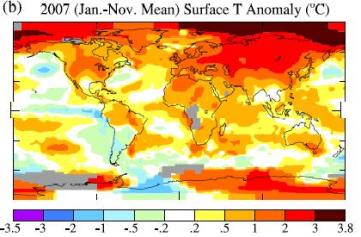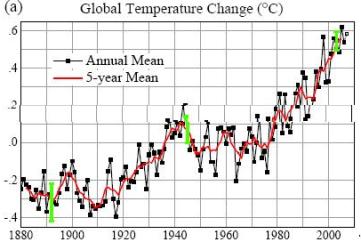Scientists: cut emissions now to avoid climate tipping point
Scientists: cut emissions now to avoid climate tipping point
mongabay.com
December 14, 2007
|
|
Countries need to act soon to cut carbon dioxide emissions if the worst impacts of global warming are to be avoided, warned a panel of scientists speaking Thursday at the fall meeting of the American Geophysical Union in San Francisco.
The scientists — James Hansen, director of NASA’s Goddard Institute for Space Studies; Richard Alley, a professor at Pennsylvania State University; Josefino Comiso, a senior researcher at NASA’s Goddard Space Flight Center; and Peter Webster, a professor at the Georgia Institute of Technology — said that Earth’s climate system is approaching tipping points that once breached may be irreversible and unstoppable on a practical time scale.
 Global map of surface temperature anomalies for first 11 months of 2007.. Courtesy of NASA |
The scientists cited unexpectedly rapid warming in the Arctic this past summer and ongoing melting of glaciers around the world as signs that the climate system is fast changing, but said that Earth has not yet passed the point of no return.
“The small warming so far is having big effect on ice,” said Alley, while noting that northern snow cover, Arctic sea ice, glaciers, the Greenland ice sheet, and the Antarctic ice sheet are all showing declines. “It’s possible that we could reach a tipping point within decades, but the impacts wouldn’t be seen for centuries.”
The scientists said mitigating the worst impacts of climate change, including melting of the ice caps, severe drought and flooding (Webster cited the Brahmaputra, Ganges, and Yangtze as being particularly susceptible), ocean acidification, and shifting climatic zones, countries must not only cut current carbon emissions but also remove carbon from the atmosphere.
 Annual surface temperature anomaly relative to 1951-1980 mean, based on surface air measurements at meteorological stations and ship and satellite measurements of sea surface temperature; the 2007 point is the 11-month anomaly. Green error bar is estimated 2s uncertainty based on quantified effect of incomplete spatial coverage and partly subjective estimate of data quality problems. Courtesy of NASA |
“We’re a lot closer to climate tipping points than we thought we were,” said Hansen during a press conference. “If we are to have any chance in avoiding the points of no return, we’re going to have to make some changes.”
Hansen said he believes it essential that industrialized countries and developing countries phase out construction of new coal-fired power plants during the next few years. He added that developing countries will need a longer time for the phase out and that technology transfers from industrialized countries will be essential in facilitating the transition to cleaner energy, including carbon capture and sequestration (CCS) technologies. Hansen noted that the vast majority of carbon dioxide presently in the atmosphere has been produced by the world’s wealthiest nations.
“The real tipping point will be when we decide to move away from fossil fuels,” he said, adding that lowering CO2 levels — through a phase out of coal, improved agricultural methods that store greater amounts of carbon in soil, and reductions in deforestation — might be easier than commonly believed.
…
In a keynote lecture Wednesday night, Lonnie Thompson, a glacier expert at Ohio State University, said tropical glaciers are showing dramatic changes in Earth’s climate system.
“Tropical glaciers are canaries in the coal mine,” he said. “Glaciers are among the first responders to global warming. They serve both as indicators and drivers of climate change.”
Thompson noted that 95 percent of 612 glaciers monitored in Tibet, 98 percent of more than 900 glaciers monitored in Alaska, and 98 percent of glaciers in the Alps are receding. In Africa, Mt Kenya and Mt Kilimanjaro are expected to lose all their glaciers before 2020.
He said that as glaciers disappear, the historical records stored in their ice are also lost. He cited signatures of thermonuclear bomb tests as an example. Some glacier ice is melting so fast that evidence of tests during the 1960s has already disappeared from the record.
Thompson said that disappearing glaciers and ice sheets could have dramatic impacts on water availability and sea levels, noting that West Antarctica stores the equivalent of 5-6 meters (16-20 feet) of sea level rise; East Antarctica, 55-60 meters of rise; and Greenland 6-7 meters.